Diversity of the judiciary 2020 statistics: report
Published 17 September 2020
Main Points
This publication is based on data covering around 16,900 barristers, 148,300 solicitors and 8,100 Chartered Legal Executives[footnote 1], 37 selection exercises run by the JAC in 2019-20 (with 8,258 applicants and 959 recommendations for legal and non-legal roles) and 3,174 court judges and 1,826 tribunal judges in post as at 1 April 2020.
The main points in this section focus first on the make-up of the legal professions, followed by judicial selection exercises, and finally diversity of the current judiciary.
Gender (section 2)
| Women are less well represented among the more experienced and more senior members of the legal professions | For those with over 15 years of legal experience - the average for those applying for judicial roles with a 5-year minimum - 32% of barristers, 43% of solicitors and 69% of Chartered Legal Executives were women, though currently few legal executives apply for judicial appointment.17% of Queens Counsel barristers and 32% of partner solicitors were women |
| Overall, there is no evidence of disparity for women for judicial selection exercises in 2019-20 | Across all legal selection exercises run by JAC, women accounted for 50% of applicants, 45% of those shortlisted and 45% of those recommended for appointment. Comparing with the pool of eligible candidates, relative success rates for women were an estimated 4% lower than for men though there were variations by appointment |
| Women remain under-represented in the judiciary, particularly in courts | At 1 April 2020, 32% of court judges and 47% of tribunal judges were women. The proportion of women has increased in recent years, but remains lower in senior court appointments (26% for High Court and above). |
Ethnicity (section 3)
| BAME representation is lower for more experienced members of the legal professions | For those with over 15 years of legal experience, 14% of barristers, 12% of solicitors and 3% of Chartered Legal Executives identified as BAME. BAME individuals represented 9% of Queen’s Counsel (barristers) and 15% of partners (solicitors) |
| BAME individuals are over-represented in applications for judicial appointment, but less likely to be successful | Across all legal exercises, candidates identifying as BAME accounted for 25% of applicants, 14% of those shortlisted and 12% of those recommended for appointment. Overall, compared to the pool of eligible candidates, success rates for BAME candidates were an estimated 17% lower than for white candidates (not statistically significant) |
| The proportion of BAME individuals in the judiciary has increased but remains lower in senior court roles | 8% of court judges and 12% of tribunal judges identified as BAME at 1 April 2020, an increase of 2 percentage points compared to 2014 in both cases. There is no clear pattern by seniority, though the proportion BAME is lower for senior court appointments (4% BAME for High Court and above) compared to others. |
Professional background (section 5)
| Representation of solicitors falls throughout the judicial selection process | Across all legal exercises combined, there was a higher representation of solicitors than barristers among applicants, though solicitors accounted for a smaller share of recommendations. Candidates who had ever been a solicitor accounted for 58% of applicants and 41% of those recommended for appointment. |
| Most court judges have a background as a barrister | Overall, 32% of court judges and 63% of tribunal judges were from non-barrister backgrounds (mostly solicitors). However in the more senior court posts (High Court and above) only 3% of current judges were non-barristers. In both courts and tribunals, the proportion with a non-barrister background has fallen compared to 2014. |
Age (section 4) and other characteristics (section 6)
| Most judges are aged 50 or over | 76% of court judges and 72% of tribunal judges were aged 50 and over, with 40% aged 60 and over in both courts and tribunals. Across all legal selection exercises, those aged 50 and over accounted for 35% of applicants, 34% of those shortlisted and 29% of those recommended for appointment. |
| There is currently limited data on other protected characteristics | Currently, reliable statistics on disability, social mobility, sexual orientation and religion are only available for judicial appointments. These show, for example, that candidates with a disability had similar recommendation rates (from application) as non-disabled candidates, whereas candidates who attended a UK state school had lower recommendation rates that those who attended fee-paying schools. |
Non-legal members of tribunals, and magistrates (section 7)
| Compared with judges, a higher proportion of non-legal members and magistrates are women, or BAME | Across all tribunal non-legal members in post as at 1 April 2020, 52% were women, 16% were BAME and 85% were aged 50 and above. 56% of sitting magistrates were women, 13% were BAME and 82% were aged 50 and above |
Statistician’s Comment
These statistics present the latest data on diversity for current judicial office holders, for judicial selection and within the legal professions which provide the eligible pool of candidates for most judicial roles.
Although the proportion of judges that are women continues to increase gradually, women remain under-represented in judicial roles in 2020. This is particularly the case in the courts where 32% of all judges, and 26% of those in more senior roles (High Court and above) were women - compared with 47% of all judges in tribunals.
The proportion of judges who identify as Black, Asian and minority ethnic (BAME) has also increased in recent years, but remains lower for court appointments compared to tribunals, particularly at senior levels (4% for High Court and above, compared with 8% of all court and 12% of all tribunal judges). However the association between age and ethnicity – with lower proportions BAME at older ages, and more senior judges being older on average – should be borne in mind.
For judicial selection exercises during 2019-20, these statistics show that overall there was no statistically significant difference in success rates for women or BAME candidates relative to the pool of eligible candidates, though this does vary between exercises. However, recommendation rates from application were significantly lower for solicitor applicants compared to barristers.
On average, applicants for judicial roles have far greater than the minimum levels of legal experience required. Within all three legal professions, gender and ethnic diversity decreases as experience and seniority increase.
Alongside figures for court and tribunal judges, this publication also covers non-legal members of tribunals and magistrates, where there is greater diversity in gender and ethnicity overall. In addition to the above characteristics this publication presents data on age, and, for judicial appointments, social mobility, disability, sexual orientation and religion, though further work is required to collect sufficiently robust data on these characteristics for the judiciary and the legal professions.
Things you need to know
Overall
This publication sets out patterns and trends relating to judicial diversity, bringing together data on legal professions (which provide the pool from which the future judiciary are drawn), judicial appointments, and sitting judges and other post holders. It covers diversity at different stages of the path to judicial office, as summarised in the image below.
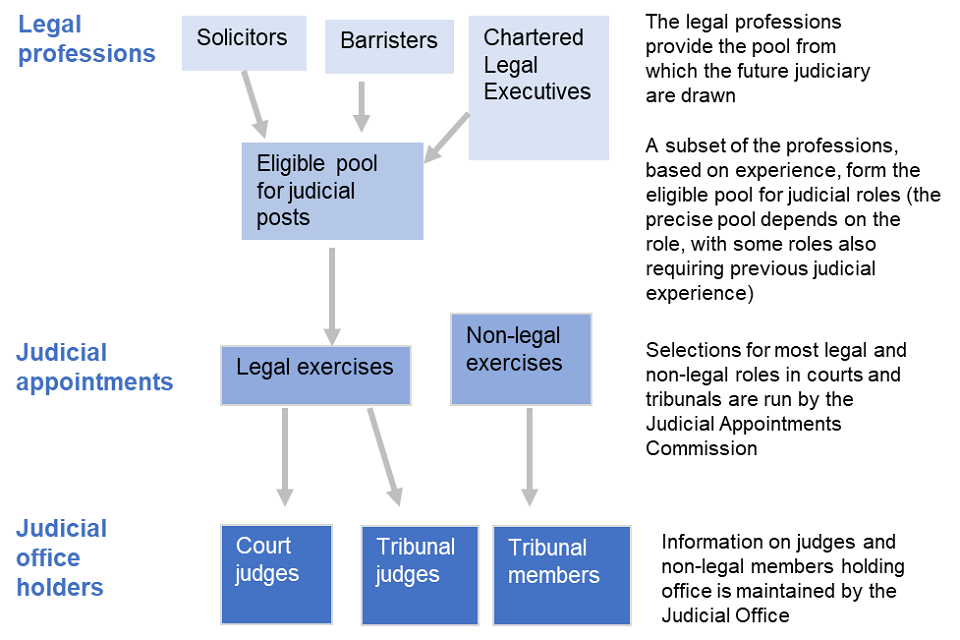
A key aim of this publication is to bring together data previously published separately into one place, to provide a comprehensive picture of the data available and evidence gaps.
Much of the diversity data included in this publication depends on voluntary self-declaration by legal profession members, judicial post applicants and judicial office holders. All percentages are calculated using the proportion of individuals where the characteristic is known. A characteristic is considered to be ‘unknown’ if an individual has asked for their data to not be shared further, has chosen ‘prefer not to say’, or has left the answer blank.
The minimum required declaration rate[footnote 2] for this publication is 60%. Where this declaration rate has not been met, the data has not been included. As declaration rates improve, we hope to include more information in future releases. Further details are given in the background guidance note.
In this publication we refer to ethnicity data using the high-level categories of those who identify as White and those who identify as coming from a BAME (Black, Asian and minority ethnic) background. The data tables in the annex provide a breakdown for the BAME groups for the legal professions and Judicial Office (JO). The breakdown is not provided for the Judicial Appointments Commission (JAC) due to the risk of disclosure from small numbers.
Legal professions
Data on the legal professions included in this publication[footnote 3] is as at 1 April 2020, with definitions as follows:
- Solicitors: all practising solicitors i.e. those who hold a practising certificate (PC).
- Barristers: all practising barristers (those who hold a PC).
- Chartered Legal Executives: all fellows of the Chartered Institute of Legal Executives (CILEx) excluding students, affiliates, associates and graduates.
Definitions of Post Qualification Experience (PQE) for each profession included in this publication:
- Solicitors: number of practising certificates held (rather than years since admission).
- Barristers: years of practice (the number of years since an individual completed pupillage).
- Chartered Legal Executives: based on years of experience for members who have achieved fellowship[footnote 4]
Definitions of seniority[footnote 5] for each profession included in this publication:
- Solicitors: solicitors at the lower level and partner at the higher level. Partner includes owners and managers of law firms. There is no equivalent way of identifying seniority for inhouse solicitors who are all included in the lower level of solicitor.
- Barristers: junior barristers (lower level) and Queens’s Counsel (QC) at the higher level.
- Chartered Legal Executives: Chartered Legal Executives that are partners represent the higher level of seniority.
Solicitors, barristers and Chartered Legal Executives comprise very different populations and professions. Their population sizes are highly varied, as are their members’ qualification and employment processes, eligibility and potential interest in applying for, and consequent representation in, the judiciary. As a result, caution is advised in making comparisons between different professions, and with the JAC and Judicial Office data. In particular, Chartered Legal Executives are unable to apply for judicial roles requiring 7 or more years legal experience.
Judicial appointments - applications and selections
The JAC figures include all exercises which closed[footnote 6], between 1 April 2019 and 31 March 2020[footnote 7]. Senior appointments[footnote 8] are not covered in the main commentary but are included in the accompanying tables, and exercises with fewer than 10 recommendations are grouped to maintain applicant confidentiality.
Recommendations from JAC selection exercises will not directly correspond to new entrants to the judiciary also covered in this publication, as there is a lag between selection exercises being completed and individuals taking up their post
Where 2 or more applicants are assessed as being of equal merit, the JAC can select an applicant for the purpose of increasing judicial diversity using the Equal Merit Provision (EMP) introduced by the Crime and Courts Act 2013. EMP can be applied at both the shortlisting and recommendation stages. The EMP was applied 19 times across 4 exercises at the shortlisting stage and 16 times across 2 exercises at the recommendation stage during the year covered.
A recommendation rate refers to the proportion of applicants (who have declared a specified characteristic) that were recommended for appointment which allows success of those with different characteristics to be compared within an exercise. These rates will depend on the number of applicants for the exercise as well as the number of posts available so that comparisons of rates between exercises should be avoided.
The Relative Rate Index (RRI) is also used to compare the relative success of two different groups, for example men and women. More information on the method of calculation and reporting can be found in the background guidance
Eligibility for judicial selection varies from one exercise to another. The Eligible Pool (EP) for an exercise presents the gender, ethnicity and professional background of individuals who meet the eligibility requirements – including minimum years of experience – for a specific legal exercise[footnote 9]. There are three broad eligibility types:
- Posts requiring a minimum 5 years legal experience, as a barrister, solicitor or Chartered Legal Executive
- Posts requiring a minimum 7 years legal experience as a barrister or solicitor
- Posts requiring previous judicial experience (in addition to a number of years legal experience)
This publication also includes figures for average years of PQE among candidates who have applied for judicial selection[footnote 10]. These are a guide to actual levels of experience of applicants, and are therefore different from the eligible pool which is based on all those eligible for a role (many of whom will not apply).
When considering applicants’ professional background (chapter 5), applicants for judicial roles are analysed based on their full career history (i.e. whether ever a solicitor, or ever a barrister) as well as their current legal role at point of application. The ‘ever’ legal role is based on applicants self-reporting and does not take account of relative time in each profession.
Judicial office holders
JO data in this publication relates to judges and non-legal members of tribunals in post as at 1 April 2020, as well as leavers and new entrants from 1 April 2019 to 31 March 2020.
Judges may hold more than one post at a time, for example some judges sit in more than once chamber, tribunal or court. In these statistics, a judge is counted only against their primary appointment, which is the one considered as their main judicial post.
The data covers all courts in England and Wales, all tribunals administered by HMCTS, Welsh tribunals not administered by HMCTS and magistrates in England and Wales. This includes the Employment Tribunal Scotland, in addition to tribunals in England and Wales. Tribunals that are the responsibility of the devolved Welsh Government are not included.
1. Overview of the legal professions and judiciary
This publication is based on data covering around 16,900 barristers, 148,300 solicitors and 8,100 Chartered Legal Executives, 37 legal and non-legal selection exercises run by the JAC in 2019-20 (with 8,258 applicants and 959 recommendations) and 3,174 court judges and 1,826 tribunal judges in post as at 1 April 2020
Of those who applied for court and tribunal positions requiring at least 5 years post-qualification experience, candidates had around 15 years’ experience on average. Of those who applied for positions requiring at least 7 years of experience, candidates had around 25 years’ experience on average.
1.1 Legal professions
As at 1 April 2020, there were 16,946 barristers, 148,284 solicitors and 8,109 Chartered Legal Executives (out of a total CILEx membership of around 20,000), based on the definitions outlined in the previous section.
The varying size of the professions should be kept in mind when interpreting the figures presented throughout this publication relating to the percentage of those in different professions with various characteristics (typically there will be more solicitors than barristers or Chartered Legal Executives). Absolute numbers are given in the accompanying data tables.
Additionally, Chartered Legal Executives are not eligible for most judicial appointments; in 2019-20, they were eligible to apply for 12 out of a total of 30 legal exercises[footnote 11].
1.2 Judicial appointments applicants and selections
Exercises in 2019-20
The JAC ran 37 selection exercises (excluding senior judicial appointments) in 2019-20[footnote 12]:
- 18 exercises were for court posts
- 19 were for tribunal posts, of which 7 were for non-legal tribunal member posts.
While this publication only makes direct reference to the 14 large legal and 5 large non-legal exercises, totals include relevant smaller exercises (unless otherwise stated).
Overall, there were 8,258 applicants, resulting in 959 recommendations for immediate appointment (s87)[footnote 13]
- 7,874 applications for legal posts, with 877 recommendations
- 384 applications for tribunal posts, with 82 recommendations.
In addition, a total of 11 applications were received and 5 recommendations made for the following senior judicial exercises completed in 2019–20: Court of Appeal[footnote 14].
Levels of experience among applicants
While information on the eligible pool for each exercise is presented (where available), the actual levels of applicants’ PQE are often greater than the statutory requirement of 5 or 7 years[footnote 15]. As a result, further diversity breakdowns for the legal professions are given in the following chapters to allow a more meaningful comparison.
- Court positions requiring 5 years PQE: average PQE of applicants was 17 years, with a range of 5 to 41 years.
- Court positions requiring 7 years PQE: average 27 years, range 7 to 48 years.
- Tribunal positions requiring 5 years PQE: average 18 years, range 5 to 41 years.
- Tribunal positions requiring 7 years PQE: average 22 years, range 7 to 38 years.
Comparison with previous years
This publication presents data for selection exercises concluded during 2019-20, and does not draw comparison to previous years as these can be affected by the number and type of exercises run in a year, which can vary according to recruitment needs.
However, in comparison to pre-JAC years (1998-99 to 2005-06), there has been a clear increase in the representation of women and BAME candidates at both the application and recommendation stages for the four appointments where data is consistently available, while the representation of solicitors has varied by exercise in the pre-JAC and JAC periods [footnote 16].
1.3 Judicial office holders
As at 1 April 2020, by primary appointments there were:
- 3,174 court judges
- 1,826 tribunal judges, with an additional 3,281 non-legal members of tribunals.
The overall number of court and tribunal judges has fluctuated over time, and there is no consistent pattern of increase or decrease. In direct comparison to 2012, the numbers of court judges (3,575 in 2012), and tribunal judges (2,060 in 2012) have both decreased.
This publication also covers new entrants to, and leavers from, the judiciary. Turnover in the judiciary tends to be relatively low, with 218 judges beginning their first appointment in 2019-20 (143 court, 75 tribunal judges) and 285 leaving in the same period (180 court, 105 tribunal).
There were 13,177 magistrates across England and Wales. The number of magistrates has fallen steadily in recent years, decreasing 48% overall from 25,170 in 2012.
2. Gender
2.1 Legal Professions
For those with over 15 years of legal experience 32% of barristers, 43% of solicitors and 69% of Chartered Legal Executives were women.
The proportion of women is notably lower for those with 20 or more years’ experience. Women are also less well represented at higher seniority levels, where 17% of Queens Counsel (barristers), 32% of partners (solicitors) and 57% of Chartered Legal Executive partners were women.
Considering each profession as a whole, compared to men, women constituted a lower proportion of barristers (38%), around half of solicitors (52%) and a higher proportion of Chartered Legal Executives (75%), though the proportion of women is lower for those with more years’ experience.
Post Qualification Experience
In practice most applicants for judicial roles have more than the minimum experience. For court and tribunal posts requiring 5 years or more experience, applicants have around 15 years’ experience on average . Among those with 15 or more years’ PQE, women constituted 32% of barristers, 43% of solicitors and 69% of Chartered Legal Executives.
For court and tribunal posts requiring 7 years or more experience, applicants have on average around 20 years’ experience[footnote 17]. Among those with 20 or more years’ PQE, women constituted 28% of barristers, 37% of solicitors (and 63% of Chartered Legal Executives, though legal executives are not eligible to apply for these roles).
Figure 1: representation of women in the legal professions by PQE band, April 2020. Across all legal professions, the proportion of women is notably lower for those having 20+ years’ experience.
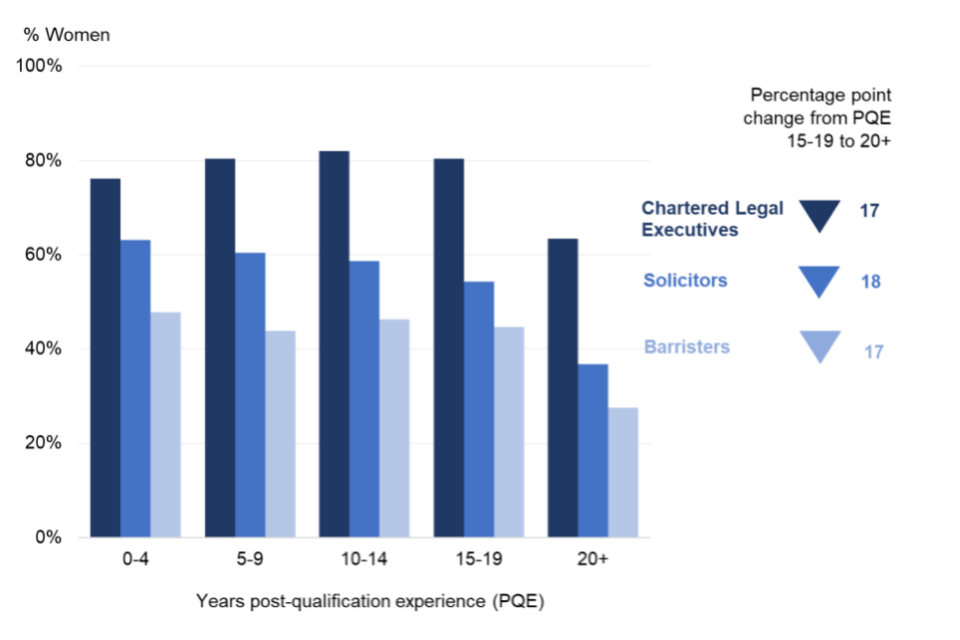
Seniority[footnote 18]
Compared to men, at April 2020:
- Among barristers, women constituted a lower proportion at both the lower (junior barrister) and higher (Queen’s Counsel) seniority levels (figure 2).
- Among solicitors, there was a larger proportion of women at lower seniority levels (solicitor), but a lower proportion of women at higher seniority levels (partner).
- Among Chartered Legal Executives, there was a larger proportion of women at both the lower (fellow) and higher (partner) seniority levels.
Figure 2: representation of women in the legal professions by seniority, April 2020. For all three professions, the proportion of women is lower at more senior compared to less senior levels.
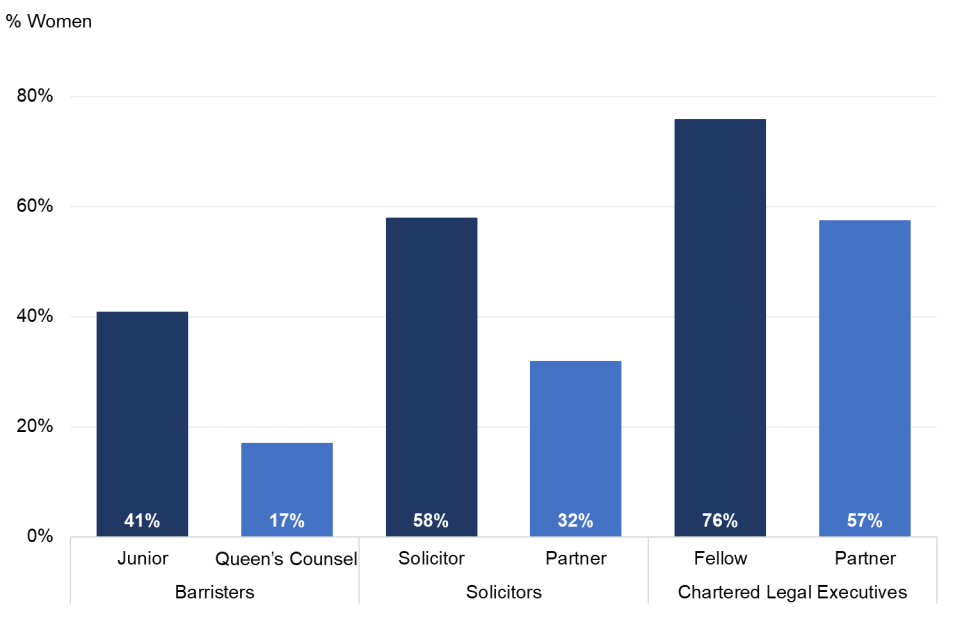
2.2 Judicial appointments applicants and selections
Across all legal JAC exercises in 2019-20, women accounted for 50% of applicants, 45% of those shortlisted and 45% of those recommended for appointment.
3,697 applicants were women, of whom 377 were recommended for appointment[footnote 19]. Overall, our best estimate is that there was no disparity for women relative to men when comparing recommendations with the eligible pool, with relative success rates for women an estimated 4% lower than for men, a difference which is not statistically significant.
Overall view
Across all legal exercises in 2019-20[footnote 20] overall, compared to the eligible pool there was no evidence of disparity for either gender. From eligible pool to recommendation, the estimated[footnote 21] RRI of 0.96 shows that overall the success rate for women was 0.96 times the rate for men (or 4% lower for women than men), a difference which is not statistically significant.
45% of recommendations were women; this compares with an expected 46% overall if recommendations were in line with the eligible pool for each exercise. Representation of women in the legal exercises remained relatively stable between the application and recommendation stages - women represented 50% of applications and 45% of those shortlisted.
Compared to men, women had a marginally higher recommendation rate from shortlisting but a lower recommendation rate from application (figure 3).
Figure 3: progression of applicants through the exercise stages by gender (all legal exercises completed in 2019-20). Difference in recommendation rate from application largely reflects differences at the shortlisting stage.

Exercise-specific analysis
There is considerable variation across exercises run in 2019-20. When considering women relative to men, from the eligible pool to recommendation we can be statistically confident a disparity exists for six of 14 large exercises (figure 4) – in two cases representing a lower success rate for women, and in four a lower success rate for men.
For example, for District Judge the RRI of 1.89 indicates that women were 1.89 times as likely (or 89% more likely) to be successful relative to men, compared to the eligible pool. Conversely for Recorder, women were 0.42 times as likely (58% less likely) to be successful.
There is a broad association between the relative success of women and the nature of the eligible pool, though caution is required in interpretation of these results:
- for 4 of the 5 roles requiring previous judicial experience, there is a relative disparity in favour of women which is large enough to be considered practically important, though in 3 cases the difference was not statistically significant
- for 3 of the 4 roles requiring at least 7 years legal experience, there is a practically significant disparity for women. It is likely that this is at least in part due to differences between the theoretical eligible pool and the pool of candidates that apply in practice; for example, most candidates applying for these roles have considerably more than the minimum experience (section 1), and among those with more experience a higher proportion are male (section 2.1)
- for roles requiring at least 5 years legal experience, there is a more mixed pattern, though for 2 of the 5 there is a statistically significant disparity in favour of women of a size large enough considered to have practical importance.
In general, women tended to have a better relative success rate for tribunal exercises, compared to courts (within each of the different groupings shown in figure 4)
Figure 4: RRI for women compared to men, from eligible pool to recommendation[footnote 22] (all legal exercises completed in 2019-20). Statistically significant results – where the confidence interval does not overlap the parity line - are dark blue. The tolerance zone is shaded grey; results falling within this zone are considered to represent a disparity which is not large enough to be considered practically important.
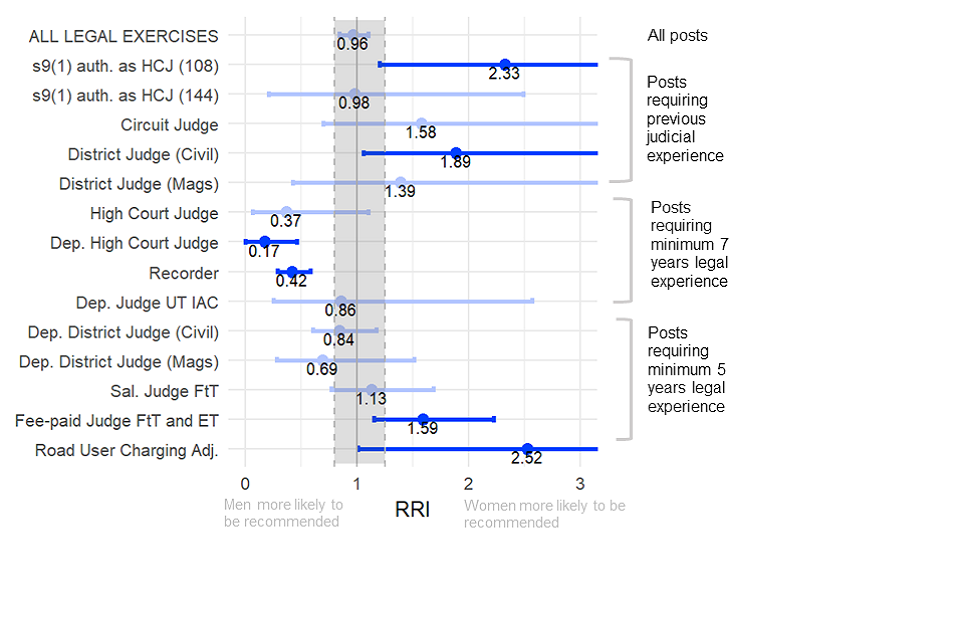
Representation rates (figure 5) help to show the progress of women at different stages of the selection process. In comparison to the eligible pool, the representation of women was higher at the recommendation stage for 7 out of 14 large legal exercises, and lower for 6. Again, there are different broad patterns depending on the nature of the eligible pool:
- For roles requiring previous judicial experience, the proportion of women tended to increase from pool to applications and then to recommendation
- However, for roles requiring 7 years legal experience, the opposite was true; the proportion of women among applicants was lower than in the eligible pool, and then fell further to recommendation (except for the High Court). As noted above, the limitations of the eligible pool, which are most notable for this group, should be borne in mind
- For roles requiring 5 years legal experience, the pattern was more mixed; for the court roles the proportion of women was lower among recommendations than the eligible pool, with the opposite pattern for tribunals
Figure 5: representation of women at different exercise stages, by eligible pool type (all legal exercises completed in 2019-20). Representation of women was higher at recommendation stage than in the eligible pool for half of these large legal exercises

2.3 Judicial office holders
32% of court judges and 47% of tribunal judges were women as at 1 April 2020.
In the courts, there was a lower representation of women in the more senior posts (26% for the High Court and above). In the tribunals, 50% of judges in senior posts (presidents[footnote 23]) were women. A higher proportion of new entrants, compared to leavers, were women.
Judges in post
As at 1 April 2020, women represented:
- 32% of all court judges – 1 percentage point higher[footnote 24] than in 2019, and 8 percentage points higher than in 2014 (figure 6).
- 47% of all tribunal judges – no change from 2019 and 4 percentage points higher than in 2014.
Figure 6: proportion of court and tribunal judges that were women as at 1 April, from 2014. The proportion of women judges remains lower in courts than tribunals, but has increased more quickly in courts in recent years.
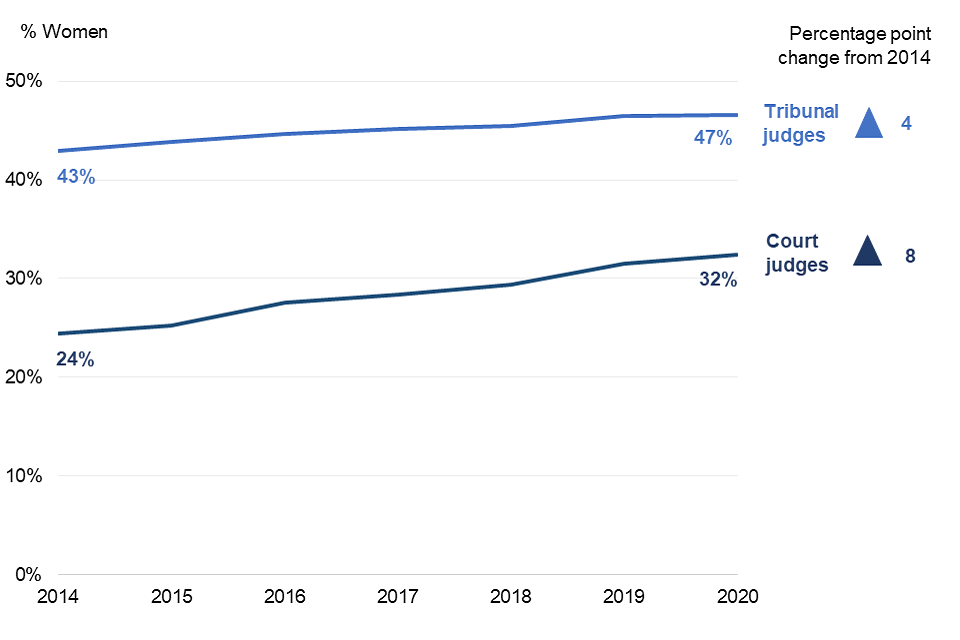
For context, women account for just over half of the general population of England and Wales aged 25-69[footnote 25]. However, as judicial roles require substantial legal experience, a direct comparison with general population is less meaningful than consideration in relation to the makeup of the legal professions (as presented in section 2.1).
Entrants and leavers
New entrants: the proportion of new entrants to the judiciary during 2019-20– those not previously holding a judicial appointment – that were women was lower compared to judges in post[footnote 26] for court judges, and broadly similar for tribunal judges (figure 7).
This figure can fluctuate from one year to the next depending on the appointments made, which do not cover all posts each year. In 2019-20, for example, most new entrants were Recorders, of which a lower than average proportion are women (23% of new entrants, and 22% of those in post).
Promotions: Among judges already holding a judicial role and promoted to another during 2019-20, 44% in courts and 47% in tribunals were women. Again, these figures can be affected by the mix of roles involved.
Leavers: A higher proportion of leavers from the judiciary were male compared to those in post, which reflects the higher proportion of older judges that are male.
For example, of those in post at 1 April 2020, 45% of court judges under 50 were women, compared with 28% of those 50 and over (and 20% of those 60 and over). There was a similar pattern in the tribunals – 51% under 50 were women, compared to 45% 50 and over.
Figure 7: representation of women among court and tribunal judges leaving and joining the judiciary, 1 April 2019 – 31 March 2020. Representation of women was higher among new entrants and those in post compared to leavers.
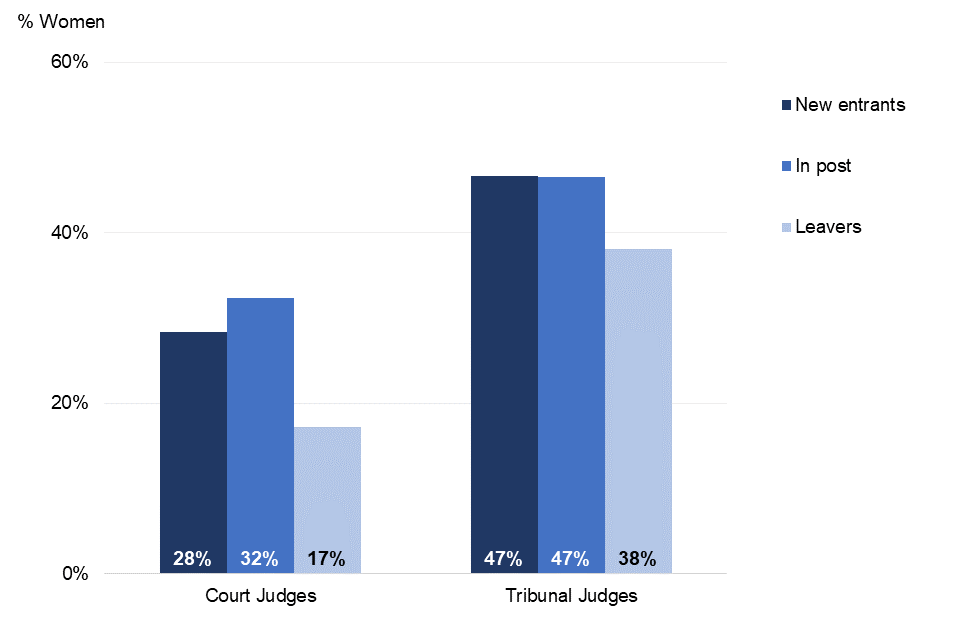
Patterns by type of appointment
The representation of women across the judiciary varied by appointment type and seniority (figure 8).
In the courts, 26% of judges in more senior posts (High Court and above) were women. The highest level of representation for women was among the District Judges (County Courts) at 44%.
In tribunals, women accounted for half of the most senior roles (Presidents, Chamber Presidents, Deputy and Vice Presidents).
Figure 8: representation of women among court and tribunal judges by appointment, 1 April 2020. The representation of women is generally lower for more senior posts in the courts.
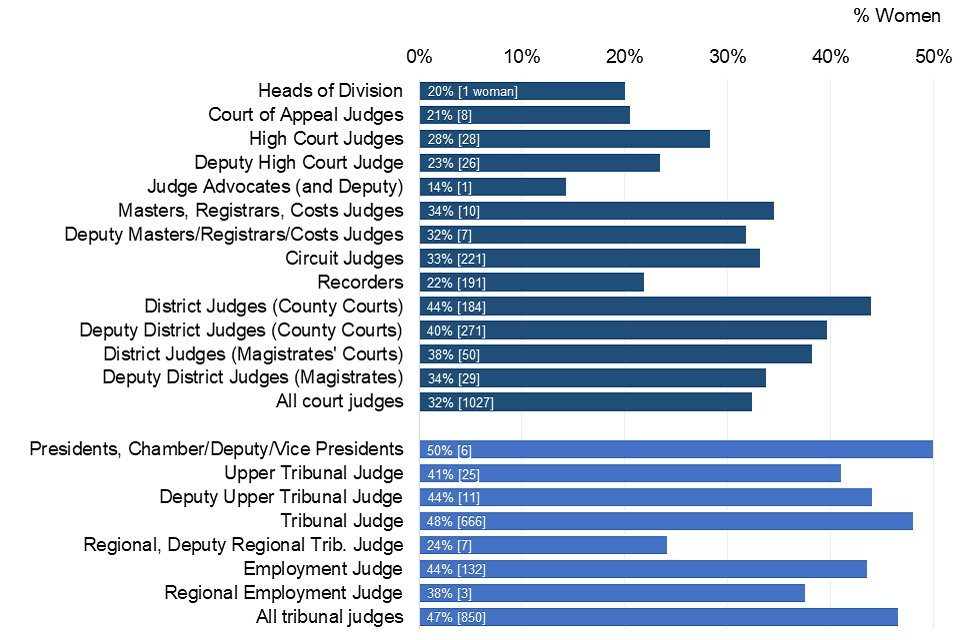
Patterns by region
The representation of women across the court judiciary also varies considerably by region, from 27% in the South West, to 41% in the South East. Variations may reflect the nature of the appointments in the different regions. Further information is available in the accompanying data tables.
3. Ethnicity
3.1 Legal professions
For those with over 15 years of legal experience, 14% of barristers, 12% of solicitors and 3% of Chartered Legal Executives were BAME.
Representation of BAME individuals is lower among those with more experience and for higher seniority levels where BAME individuals represented 9% of Queen’s Counsel (barristers), 15% of partners (solicitors) and 4% of partners (Chartered Legal Executives).
Considering each profession as a whole, BAME individuals constituted 15% of barristers, 18% of solicitors and 10% of Chartered Legal Executives, though BAME representation generally fell with increasing experience and seniority.
Post Qualification Experience
In practice, most applicants for judicial roles have more than the minimum experience. For court and tribunal posts requiring 5 years or more experience, applicants have on average around 15 years’ experience[footnote 27]. Among those with 15 or more years’ PQE, BAME individuals constituted 14% of barristers, 12% of solicitors and 3% of Chartered Legal Executives.
For court and tribunal posts requiring 7 years or more experience, applicants have on average around 20 years’ experience[footnote 27]. Among those with 20 or more years’ PQE, BAME individuals constituted 12% of barristers and 9% of solicitors.
Figure 9: representation of BAME individuals in the legal professions by PQE band, April 2020[footnote 28]. For each profession, the proportion of BAME individuals is lower for those with 20+ years’ experience.
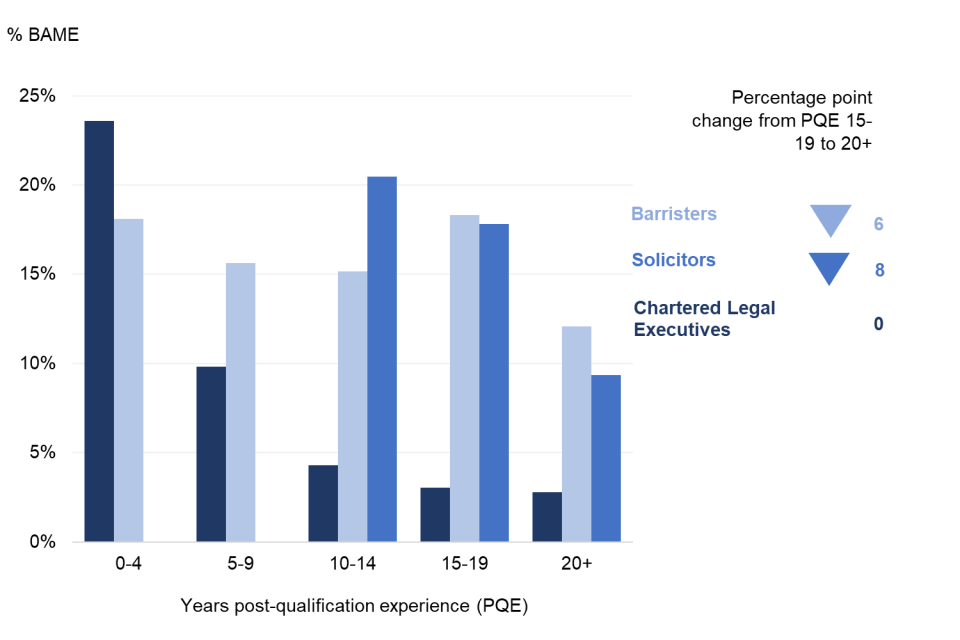
Seniority[footnote 29]
For all three legal professions, BAME individuals constituted a smaller proportion of individuals at higher compared to lower seniority levels (figure 10).
Figure 10: representation of BAME individuals by seniority in the legal professions, April 2020. The proportion of BAME individuals is lower at the more senior levels within all three professions.
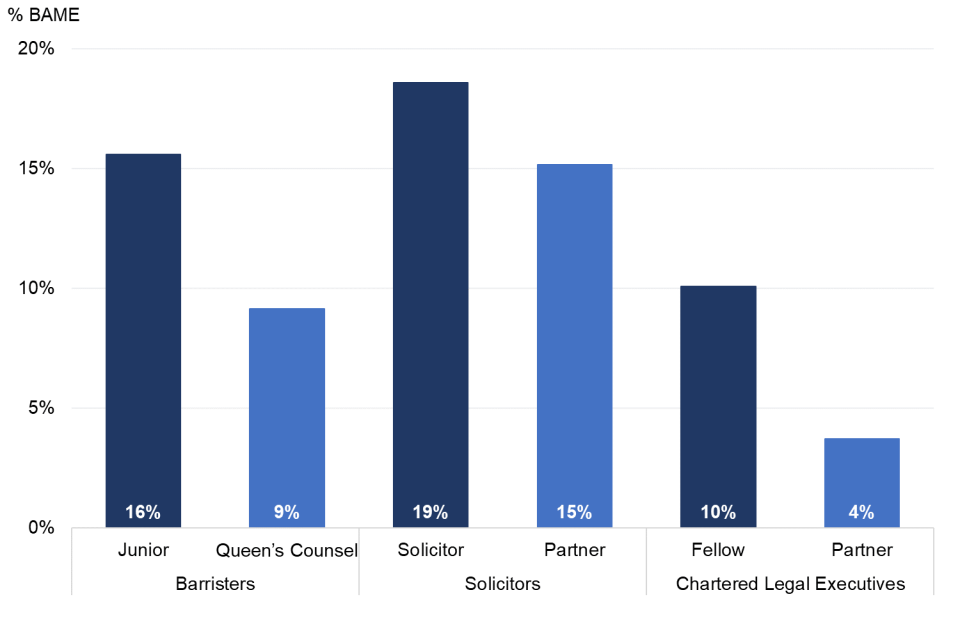
3.2 Judicial appointments applicants and selections
Across all legal exercises in 2019-20, BAME candidates accounted for 25% of applicants, 14% of those shortlisted and 12% of those recommended for appointment.
1,849 applicants identified as BAME, with 101 recommended for appointment[footnote 30].
Overall, compared to the eligible pool, success rates for BAME candidates were an estimated 17% lower than for white candidates, a difference not considered to be statistically or practically significant.
Overall view
Across all legal exercises in 2019-20, overall:
- compared to the eligible pool success rates for BAME candidates were an estimated 17% lower than for white candidates (shown by the estimated[footnote 31] RRI of 0.83). However, this is within the range considered to be not practically significant, nor can we be statistically confident that any difference exists
- BAME candidates represented 25% of applicants and 12% of recommendations (figure 13); this compares with an estimated 15% of recommendations expected if these were in line with the eligible pool
- both the shortlisting rate from application, and recommendation rate from shortlisting were lower for BAME than white candidates (figure 11)
Figure 11: progression of applicants through the exercise stages by ethnicity (all legal exercises completed in 2019-20). Differences in shortlisting rate from application are the biggest contributor to the overall difference in recommendation rates between white and BAME candidates.

Exercise-specific analysis
When considering BAME candidates relative to white (figure 12), from the eligible pool to recommendation:
- we can only be statistically confident that there is a disparity for two exercises, both fee paid court roles – Deputy High Court Judge (success rates for BAME candidates 75% lower than white) and Recorder (success rates for BAME candidates 59% lower)
- as with gender, there are broad patterns related to the nature of the eligible pool, which may reflect some limitations with how the theoretical pool relates to those who apply for judicial roles in practice
- for all 4 roles requiring previous judicial experience, success rates for BAME candidates are higher than white (though these differences are not statistically significant, given the relatively small numbers involved)
- for the 3 of the 4 roles requiring a minimum of 7 years’ legal experience, BAME candidates’ success rates were lower (these 3 were the 3 court roles)
- for the 5 roles requiring a minimum of 5 years’ legal experience, BAME candidates again had lower success rates, although not to the same extent (and again, where differences are not statistically significant)
Figure 12: RRI for BAME compared to white candidates from eligible pool to recommendation (large legal exercises completed 2019-20). Statistically significant results – where the confidence interval does not overlap the parity line - are dark blue. The tolerance zone is shaded grey; results falling within this zone are considered to represent no practical disparity.
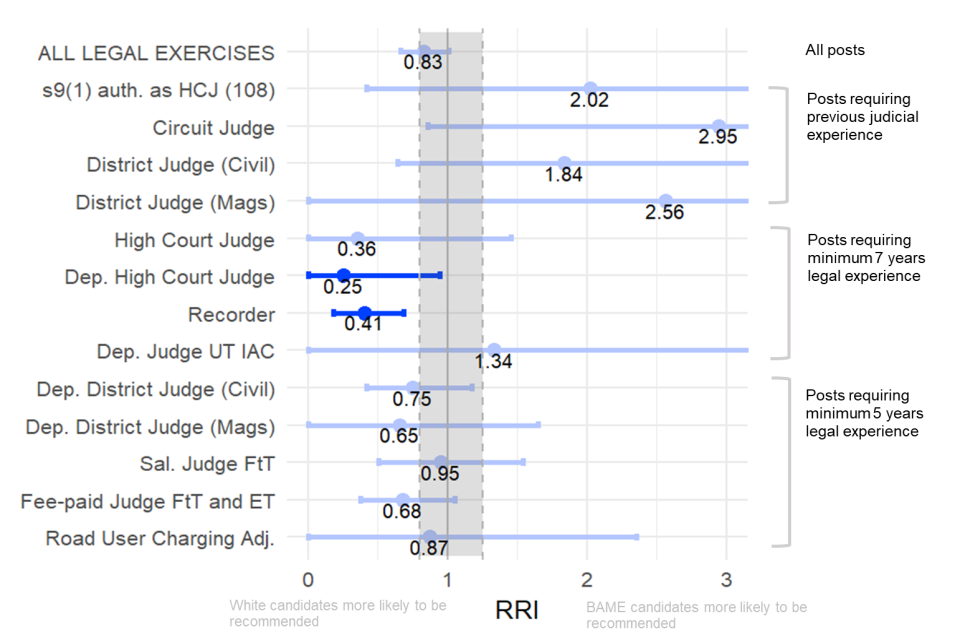
Considering the representation rates at different stages (figure 13):
- in all cases the proportion of BAME applicants was higher than in the corresponding eligible pool, but (except for Circuit Judge) the proportion of recommendations that were BAME candidates was then lower than among applicants
- there are different patterns depending on whether previous judicial experience was required
- for roles which required previous judicial experience, there was (except for District Judge) a small or no fall in the proportion of BAME candidates from application to recommendation
- however, for all the roles where judicial experience was not required there was a notable fall in the BAME proportion between application and recommendation in all cases, so that (except for Deputy Upper Tribunal Judge) the proportion BAME among recommended candidates was lower than in the eligible pool
Figure 13: representation of BAME candidates at different exercise stages (large legal exercises completed in 2019-20). BAME proportion higher among applicants than the eligible pool, but a lower share of recommendations than applications.

3.3 Judicial office holders
8% of court judges and 12% of tribunal judges were BAME at 1 April 2020.
The representation of BAME individuals varied with appointment type, and was lower for senior court posts (4% for High Court and above) though there was no clear pattern with regards to seniority overall. BAME individuals were represented at a higher level among new entrants and those in post, compared to leavers.
Judges in post
As at 1 April 2020, BAME individuals represented:
- 8% of all court judges, no change compared the previous year[footnote 32] and 2 percentage points higher compared to 2014
- 12% of all tribunal judges, no change compared the previous year[footnote 26] and 2 percentage points higher than 2014 (figure 14)
Figure 14: representation of BAME individuals among court and tribunal judges from 2014. BAME representation has increased slightly in recent years.

When comparing the BAME representation among judges to that of the general population, it is important to consider the relationship between age and ethnicity. As very broad context, around 13% of the population of England and Wales aged 25-69 were BAME based on the 2011 Census[footnote 33]. However, judges are older on average than the working age population and distributed towards the upper ages of this range (see section 4), where the proportion BAME is lower. Comparing proportions by age group shows broadly similar patterns, with the exception of those under 50 (figure 15).
Note that as there is a 9-year gap between the judicial and Census data, and a likely increase in the BAME share of population over this period, the actual proportions shown are not directly comparable. Data for the legal professions (section 3.1) also provides context for the BAME proportion among the judiciary.
Despite limitations in making comparisons, the age of judges should be kept in mind when considering variations in the proportion BAME, e.g. by appointment type.
Figure 15: representation of BAME individuals by age group - court and tribunal judges (2020) compared to general population (2011 Census)[footnote 34].
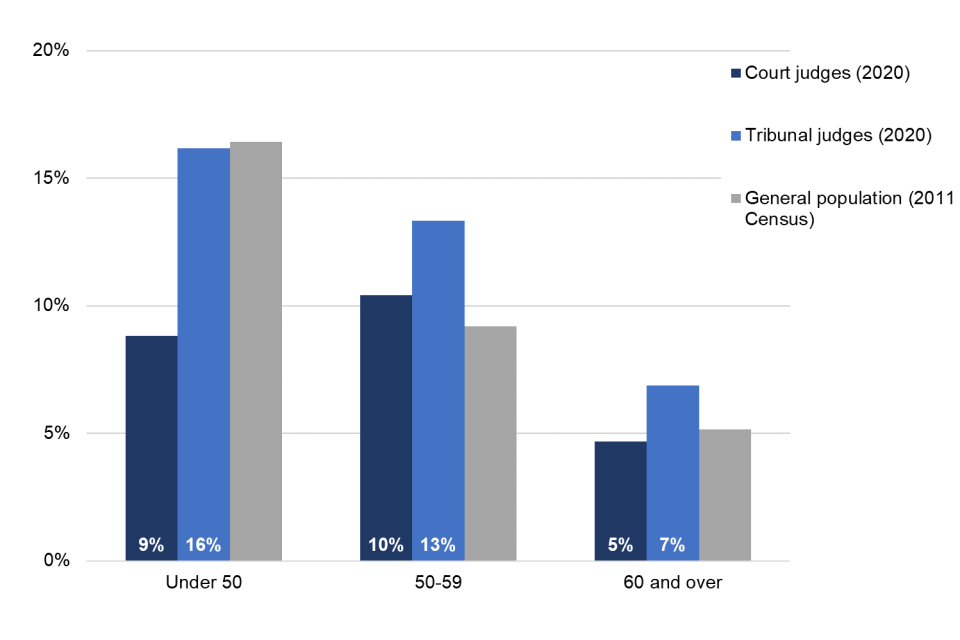
Entrants and leavers
Entrants: for court and tribunal judges in 2019-20, the proportion of BAME individuals entering the judiciary was higher than of those in post as at 1 April 2020 for the tribunals, but lower for the courts (figure 16). As with gender, these figures are likely to fluctuate depending on which roles were appointed during the year.
Promotions: BAME individuals constituted 9% of promotions in the courts and 11% of promotions in the tribunals.
Leavers: conversely, a lower proportion of judges leaving the judiciary – who are older on average – in 2019-20 were BAME compared to those in post. The recent increase in the proportion of BAME individuals in post can be associated with the fact that a higher proportion of new entrants, compared to leavers, were BAME.
Figure 16: representation of BAME individuals among court and tribunal judges leaving and joining the judiciary, 1 April 2019 – 31 March 2020. The representation of BAME individuals was higher among new entrants and in post than leavers.
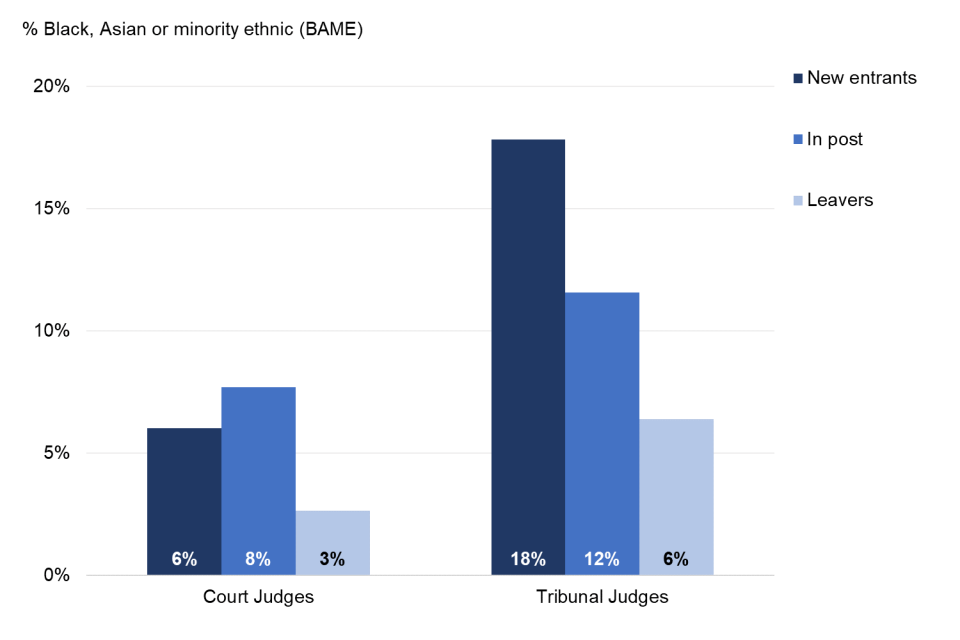
Patterns by type of appointment
In the courts, representation of BAME individuals was higher for Deputy High Court Judges (figure 17) but otherwise generally lower for the more senior appointments (e.g. Court of Appeal, High Court and Circuit Judge) with 4% of judges in the High Court or above self-identifying as BAME.
BAME representation was higher among judges of the Upper Tribunal than tribunals overall, though there were no BAME judges in the most senior tribunal positions (presidents).
Figure 17: representation of BAME individuals among court and tribunal judges by appointment, 1 April 2020. The representation of BAME individuals varied with appointment-type, but there was no clear pattern with regards to seniority.

Patterns by region
The proportion of BAME court judges also varied by region, from 10% in London and the Midlands, to 3% in Wales. Together, nearly 70% of BAME court judges are in London and the Midlands.
This is likely to reflect, to some extent, variations in the BAME proportion of general population by region, which is considerably higher in London than other regions.
4. Age
4.1 Legal professions
For those with over 15 years of legal experience, over half are aged 50 and over – 59% of barristers, 56% of solicitors and 80% of Chartered Legal Executives.
A higher proportion of those in more senior roles are aged 50 and over, compared to those in more junior positions.
Post Qualification Experience
Experience is strongly associated with age (figure 18).
- Of those with 15 or more years’ experience, 59% of barristers, 56% of solicitors and 80% of Chartered Legal Executives are aged 50 and over
Figure 18: age group for different levels of post-qualification experience in the legal professions, April 2020. A similar pattern across all legal professions, with over half of those with 15 or more years PQE being aged 50 and over.

Seniority
A higher proportion of those in more senior roles are aged 50 or over, compared to those in more junior positions:
- for barristers, 69% of QCs, compared with 32% of junior barristers
- for solicitors, 50% of partners compared with 23% of solicitor
- for Chartered Legal Executives, 63% of partners compared with 43% of fellows
4.2 Judicial appointments applicants and selections
Across all legal exercises, those aged 50 and over accounted for 35% of applicants, 34% of those shortlisted and 29% of those recommended for appointment.
Age and experience are related, and the proportion of individuals aged 50 and over was higher among the applicants and recommendations made for more senior positions.
Age is strongly correlated with experience and, as a result, it is less insightful to make comparisons between recommendation rates based on age than for other characteristics. As such, although figures are broken down by age group, we do not conduct relative comparisons of rates of recommendation.
Overall View
Overall, 35% of applicants to legal exercises were aged 50 and over; representation of those over 50 decreased between application and recommendation stages with 34% of those shortlisted and 29% of recommendations for individuals aged 50 and above.
Exercise-specific analysis
More senior roles typically require greater experience and therefore older age groups are more highly represented at both application and recommendation stages (figure 19).
The proportion of individuals aged 50 and over tends to decrease between the application and recommendation stages, though this was not the case for every exercise.
Figure 19: proportion of applicants and recommendations aged 50 and over for each large legal exercise. Proportion of applicants and recommendations who are aged 50 and over broadly increases with seniority of post.
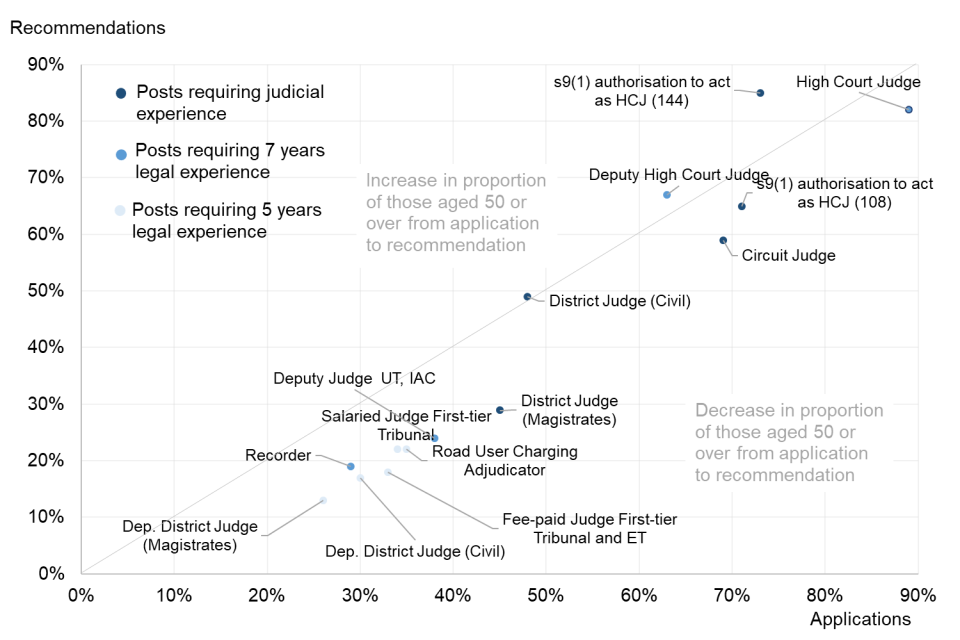
4.3 Judicial office holders
76% of court judges and 72% of tribunal judges were aged 50 and over, with 40% aged 60 and over in both courts and tribunals.
Within the courts, there was a lower representation of younger ages in the more senior posts.
Judges in post
At 1 April 2020, around three-quarters of judges were aged 50 and over - 76% in courts, and 72% in tribunals. In both courts and tribunals, 40% of judges were aged 60 and over.
Entrants and leavers
For judges in both courts and tribunals, around a quarter of new entrants to the judiciary in 2019-20 were aged under 50. Almost all those leaving the judiciary were aged 50 and over[footnote 35].
Patterns by type of appointment
Overall, the proportion of those aged 50 and over, and 60 and over, was higher among the more senior posts (particularly Court of Appeal and above) (figure 20).
There was a broadly similar pattern in the tribunals, where tribunal presidents were all aged 50 or over, compared with 71% of tribunal judges.
Figure 20: representation of ages 50 and over among court and tribunal judges by appointment, 1 April 2020. The representation varied with appointment type, and was higher for the more senior posts in the courts.
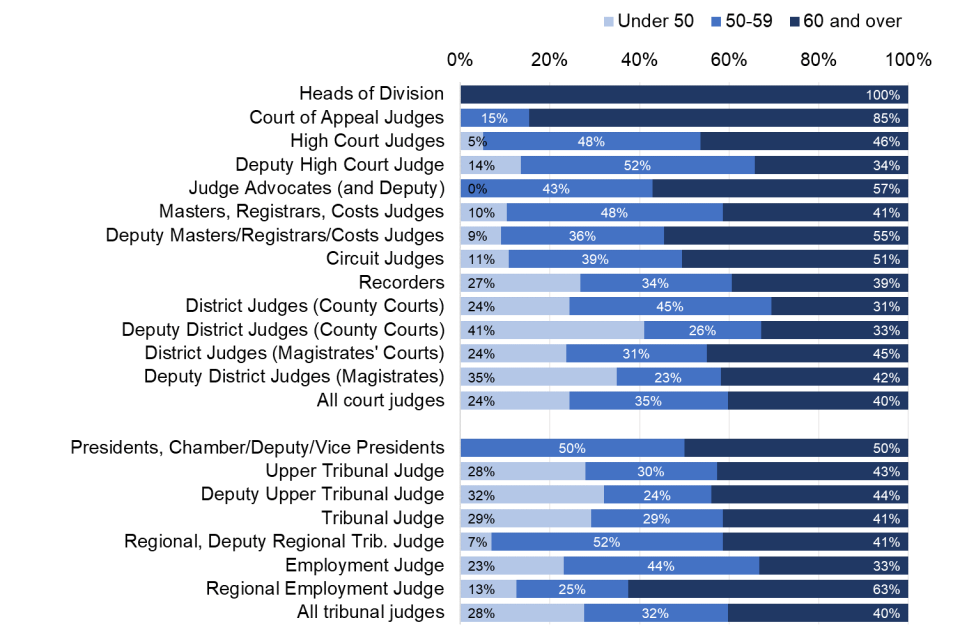
5. Professional Background
5.1 Judicial appointments applicants and selections
Across all legal exercises combined, there was a higher representation of solicitors than barristers among applicants. However, solicitors constituted a smaller percentage of recommendations. Chartered Legal Executives constituted 1% of all applicants.
Candidates who were ever solicitors accounted for 58% of applicants (4,225) and 41% of those recommended for appointment (337). Candidates who were current solicitors accounted for 52% of applicants (3,814) and 33% of those recommended for appointment (271).
The professional background of applicants for judicial appointment is analysed using two separate methods:
-
‘current legal role’ compares applicants who have declared their current legal role as solicitor with those declaring their current legal role as barrister[footnote 36]
-
‘ever legal role’[footnote 37] compares those who have ever been a solicitor to those who have ever been a barrister. This includes those who currently hold a legal role of barrister or solicitor and those who have declared holding the role of barrister or solicitor at any stage in their career[footnote 38].
Around 10% more applicants were identified as solicitors using the wider definition of ever legal role, though the same broad patterns are shown for both measures and as a result the focus below is on the ‘ever legal role’[footnote 39].
Overall, 84 applicants (1%) declared holding the role of CILEx professional at application. 8 of these were shortlisted and 3 recommended for immediate appointment. It is important to note that CILEx fellows are only eligible to apply for a limited number of exercises and given the small numbers are not consider further here[footnote 40].
Overall view
Across all legal exercises in 2019-20:
- from application[footnote 41] to recommendation, we can be confident a disparity of practical significance exists between solicitors and barristers; candidates who were ever solicitors, were 50% less likely to be successful relative to ‘ever barristers’ (shown by the RRI of 0.50; for current solicitors relative to current barristers, the equivalent RRI is 0.46)
- candidates who were ever solicitors made up 41% of the recommendations for appointment (compared to 59% for ever barrister). For current solicitors, the equivalent figure was 33% (compared to 50% for barristers and 17% for other roles)
- recommendation rates for candidates who were ever solicitors were lower than for candidates who were ever barristers, with the biggest difference at the shortlisting stage (figure 21). A similar pattern exists for the current legal role measure
Figure 21: progression of applicants through the exercise stages by ‘ever’ legal role (all legal exercises completed in 2019-20)[footnote 42]. Representation of solicitors fell from application to shortlisting, and from shortlisting to recommendation.
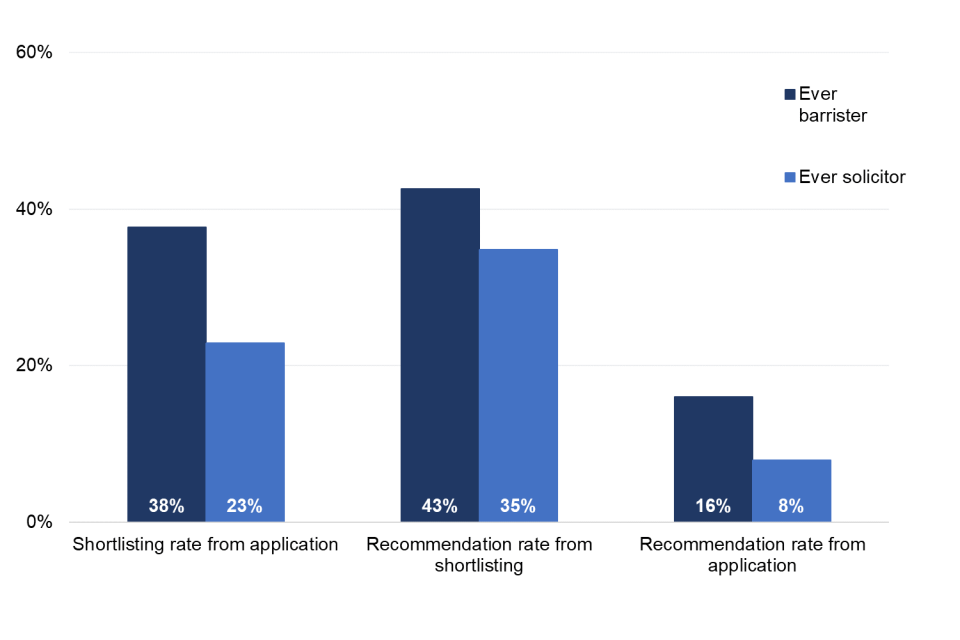
Exercise-specific analysis
Considering the results for individual exercises:
- in 11 out of 14 selection exercises, there was a disparity in success rates from application to recommendation for ‘ever solicitors’ compared to ‘ever barristers’ large enough to be considered practically significant; in 5 cases the difference was also statistically significant i.e. unlikely to have occurred due to chance (figure 22)
- there was one exercise – Deputy District Judge (Magistrates Court) where there were higher success rates for ‘ever solicitors’ considered practically significant, though not statistically significant
- the disparity for solicitors is in general lower for roles where judicial experience is required, though there is a broadly consistent pattern shown across exercises with the different types of eligible pool
- comparing representation rates for ‘ever solicitors’ at application and recommendation stages shows the same patterns in a different way (figure 23). This also shows that the proportion of both applicants and recommendations that are ever solicitors is typically higher for the posts requiring 5 years legal experience, and typically lower for more senior court posts (e.g. High Court Judge and Circuit Judge)
Figure 22: RRI for ‘ever solicitors’ compared to ever barristers, from application to recommendation (large legal exercises completed in 2019-20). Statistically significant results – where the confidence interval does not overlap the parity line - are dark blue. The tolerance zone is shaded grey; results falling within this zone are considered to represent no practical disparity.
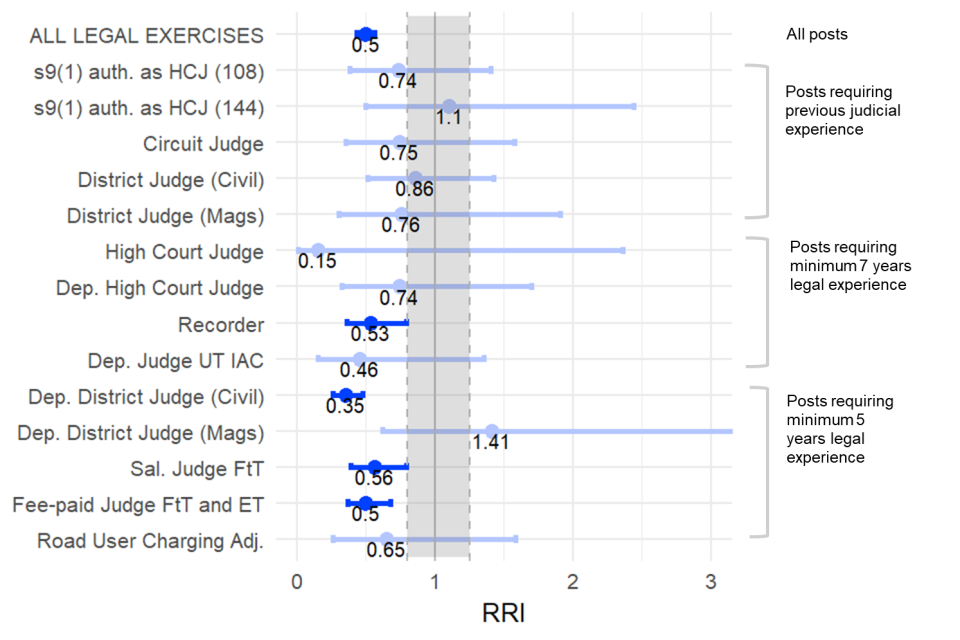
Figure 23: representation of ever solicitors by exercise stage, large legal exercises[footnote 43]. Solicitor representation fell between application and recommendation for 12 out of 14 exercises.

5.2 Judicial office holders
32% of court judges and 63% of tribunal judges were from non-barrister backgrounds.
In the courts, non-barristers constituted 3% of all judges in more senior posts (High Court and above). In the tribunals, 58% of judges in more senior posts (presidents, including deputy and vice) were non-barristers.
Judges in post
As at 1 April 2020:
- non-barristers represented 32% of all court judges and 63% of all tribunal judges. Compared to 2014, this is a 4 percentage point decrease among court judges, and compared to 2015 a 5 percentage point decrease among tribunal judges (figure 24)[footnote 44]
- the majority of judges from a non-barrister background were former solicitors with only 5 court judges and 31 tribunal judges coming from a legal executive or any other legal background[footnote 45]
Figure 24: representation of non-barristers among court and tribunal judges, from 2014. Non-barristers remain better represented among tribunal judges, though non-barrister representation has reduced over time in both courts and tribunals.
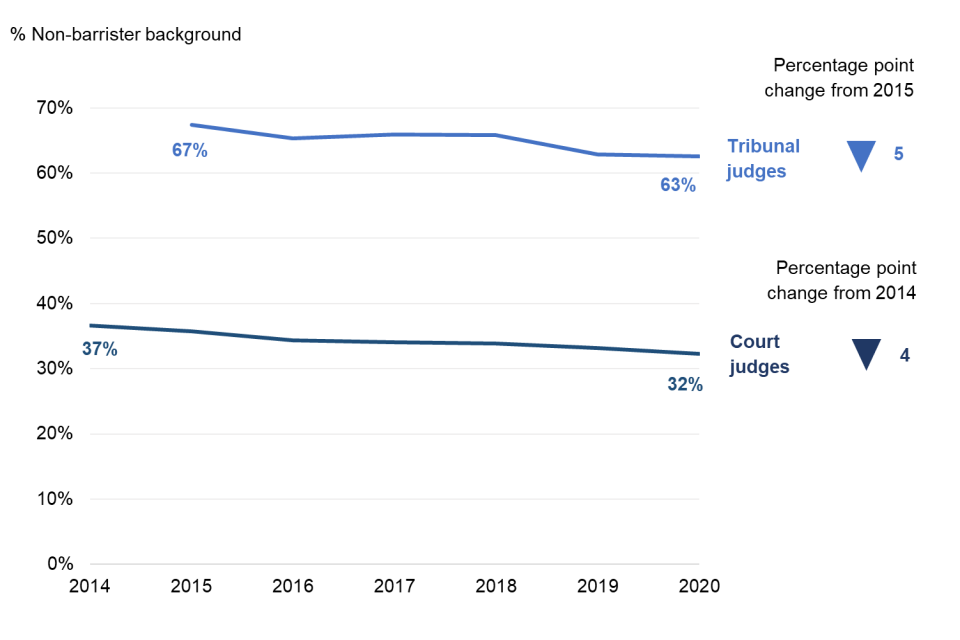
Entrants and leavers
For court and tribunal judges, in 2019-20, the proportion of non-barristers leaving the judiciary was higher than of those in post and those entering in 2019-20 (figure 25).
The decrease (from 2019) in the proportion of non-barristers in post among court judges can be associated with the fact that a higher proportion of leavers, compared to new entrants, were non-barristers.
Among tribunal judges, half (50%) of those promoted were from non-barrister backgrounds – this compares with 43% of promotions for court judges.
Figure 25: representation of non-barristers among court and tribunal judges leaving and joining the judiciary, 1 April 2019 – 31 March 2020. The representation of non-barristers was higher among leavers compared to new entrants and those in post, especially for court judges.

Patterns by type of appointment
Within the courts, non-barristers had a higher representation among the less senior judicial posts. 3% of all judges in the senior posts (High Court and above) were non-barristers (figure 26). Conversely, the proportion non-barristers among District Judges and Deputy District Judges was at least 60%.
Within the tribunals, representation of non-barristers was more evenly distributed across the different appointments.
Figure 26: representation of non-barristers among court and tribunal judges, by appointment, 1 April 2020. The representation of non-barristers was higher among the less senior posts in the courts, but was evenly distributed in the tribunals.

6. Other diversity characteristics
6.1 Judicial appointments applicants and selections
Disability: For legal exercises overall, candidates with a disability had a similar recommendation rate from application as candidates without a disability (both 11%).
Social mobility: Over all legal exercises, candidates who attended a UK state school had a lower recommendation rate from application (11%) compared to those who attended a UK independent or fee-paying school (14%).
Sexual orientation: Across all legal and non-legal exercises combined, candidates who were lesbian, gay or bisexual had a lower representation but a higher recommendation rate from application (16%) than candidates who were heterosexual (11%).
Religion: Across all exercises (legal and non-legal) candidates who declared their religion as Church of England accounted for the largest share of applications and recommendations, while those Jewish or of no religion had the highest recommendation rates from application (15%).
This section presents available statistics for other diversity characteristics – disability, social mobility, religion and sexual orientation. Currently these are only collected in a sufficiently robust way for judicial selection, and not for judges in post or the legal professions. A brief summary is presented here, with further details in the accompanying data tables.
Disability
Overall, across all legal exercises candidates with a disability:
- represented 8% of applications and 7% of all recommendations made
- had a similar recommendation rate from application as candidates without a disability (11%)
Social mobility
Across all legal exercises, individuals who attended a UK state school:
- represented 73% of applicants and 71% of recommendations made
- had a lower recommendation rate from application (11%) compared to those who attended a UK independent or fee-paying school (14%)
Across all legal exercises, almost all (99%) of applicants attended university
- however, 63% of applicants and 57% of those recommended were the first generation in their family to do so (i.e. had parents who did not attend university)
- candidates who did not attend university had a lower recommendation rate from application (5%) compared to candidates who did attend university but whose parents did not (10%) and candidates who did attend university and whose parents also attended university (14%)
Sexual orientation
Across all exercises (legal and non-legal) combined[footnote 46]:
- 6% of applicants were lesbian, gay or bisexual
- candidates who declared themselves to be lesbian, gay or bisexual (16%) had a higher recommendation rate from application compared to those who declared themselves to be heterosexual (11%)
Religion
Across all exercises (legal and non-legal) combined[footnote 47]:
- the religion or belief with the largest representation among both applicants and recommendations was Church of England (31% and 34% respectively), followed by individuals who declared no religion (25% and 34% respectively)
- the highest recommendation rates from application were for candidates who declared themselves to be Jewish or of no religion (both 15%), followed by candidates who declared themselves as Church of England (12%)
7. Non-legal tribunal members and Magistrates
Non-legal members – appointments and selections: 41% of recommendations for non-legal members were women, 23% were BAME and 44% were aged above 50.
Non-legal members in post: 52% of sitting non-legal members were women, 16% were BAME and 85% were aged above 50 as at 1 April 2020.
Magistrates: 56% of sitting magistrates were women. 13% were BAME and 82% were aged above 50 as at 1 April 2020.
This section covers roles which do not require a legal background – non-legal members in tribunals, and magistrates. This compares with preceding sections which focus on legal professions, selections for judicial posts requiring legal experience and judges in post. While non-legal posts typically have eligibility criteria (for example, membership of an appropriate professional body) no attempt is currently made to estimate the eligible pool.
7.1 Applications and selections for non-legal tribunal members
Gender
Across all non-legal exercises overall:
- women represented 41% of recommendations
- comparing application to recommendation stages for non-legal exercises as a whole, success rates for women were 40% higher than for men (RRI = 1.40) though this is not statistically significant
Compared to men, the recommendation rate from application was higher or equivalent for women in all 5 large non-legal exercises.
Ethnicity
Across all non-legal exercises overall:
- BAME candidates made up 23% of recommendations
- comparing application to recommendation stages for non-legal exercises as a whole, success rates for BAME candidates were 40% higher than for white candidates (RRI = 1.40) though this is not statistically significant
For individual exercises, in one case BAME candidates had a higher recommendation rate from application compared to white, and in another a lower recommendation rate[footnote 48].
Age
Across all non-legal exercises overall:
- 44% of those recommended for appointment were aged 50 or over
Recommendation rates from application varied by exercise, with some exercises having a higher rate amongst older candidates and others having a higher recommendation rate amongst younger candidates.
Disability
Across all non-legal exercises overall:
- 11% of applicants and 8% of those recommended declared themselves to have a disability
- the recommendation rate from application for candidates with a disability was lower (17%) than for candidates with no disability (22%)
Social mobility
Across all non-legal exercise overall:
- candidates who attended a UK state school accounted for 74% of both applicants and those recommended, but had a lower recommendation rate from application (23%) compared to those who attended a UK independent or fee-paying school (26%)
- candidates who attended university, but whose parents did not, accounted for the majority of applicants (67%) and recommendations (68%)
- Candidates who did not attend university – who accounted for 5% of applications - had a lower recommendation rate from application (18%) compared to candidates who did attend university but whose parents did not (22%) and candidates who did attend university and whose parents also attended university (23%)
7.2 Non-legal tribunal members and magistrates in post
Gender
As at 1 April 2020, women represented 52% of all non-legal members of tribunals (7 percentage points higher than in 2014) and 56% of all magistrates (4 percentage points higher than in 2014).
The representation of women varied by the type of non-legal post, with 45% of medical members and 76% of disability members being women.
The proportion of women entering non-legal member roles in 2019-20 (56%) was higher than for those in post as at 1 April 2020.
Ethnicity
As at 1 April 2020, BAME individuals represented 16% of all non-legal members of tribunals (1 percentage point higher than in 2014) and 13% of all magistrates (a 5 percentage point increase from 2014 when 8% declared themselves as BAME).
BAME representation varied by the type of non-legal post, with 28% of medical members and 6% of disability members being BAME individuals.
The proportion of BAME individuals among non-legal members new entrants in 2019-20 was lower than of those in post as at 1 April 2020. In part this reflects the type of new entrants – in 2019-20, these were for other tribunal members (i.e. not medical or disability tribunal members – mostly Employment Tribunal members).
Age
Non-legal members tended to be older than judges on average, with 85% of those in post being 50 and over, and 57% being 60 and over. This is similar to magistrates in post, where 82% were aged 50 or over, and 49% aged 60 and over.
For non-legal member posts in tribunals, over half (74%) of new entrants were aged 50 and over. The majority of leavers were aged 50 and over.
Further information
Accompanying files
As well as this publication, the following products are published as part of this release:
- a supporting guide providing further information on how the data is collected and processed, and including information about the quality of the statistics in relation to their use
- a set of data tables, providing more detailed statistics on the legal professions, judicial selection and judicial office holders
Official statistics status
These are official statistics which should comply with all aspects of the Code of Practice for Statistics.
General information about the official statistics system of the United Kingdom is available from: uksa.statisticsauthority.gov.uk/about-the-authority/uk-statistical-system/
Future publications
Our statisticians regularly review the content of publications. As part of our continual review and prioritisation, we welcome user feedback on existing outputs including content, breadth, frequency and methodology. Please send any comments you have on this publication including suggestions for further developments or reductions in content.
Next update: scheduled for July 2021
Contact
Enquiries and feedback on these statistics should be directed to the Justice Statistics Analytical Services division of the Ministry of Justice:
Julian Sandler or Matthew Tranter – email judicial.statistics@justice.gov.uk
Media or other queries on the wider policy implications of these statistics should be directed to the relevant contact:
Judicial appointments: Jessica Prandle - email jessica.prandle@judicialappointments.gov.uk or communications@judicialappointments.gov.uk
Judiciary: Katy Durrans or Michael Duncan - email katy.durrans@judiciary.uk or michael.duncan@judiciary.uk
-
Solicitors, barristers and Chartered Legal Executives comprise very different populations and professions, and in particular legal executives are not eligible to apply for all judicial roles. See ‘things you need to know’. ↩
-
The percentage of individuals who have declared their diversity characteristics as a proportion of the total population. ↩
-
Data used has been provided for this publication specifically and may not match diversity data which is published separately by the professional bodies. For example, figures for solicitors are differ from the published firm diversity data which is collected by law firms and published by the SRA based on a slightly different subset of the population. ↩
-
Individuals who have completed the academic stage of training, been in qualifying employment for at least 3 years (at least one in the Graduate membership grade of CILEx) and have met the Work Based Learning outcomes. ↩
-
It is important to note that the measures of seniority for each profession are not equivalent. In particular, for barristers, QC status is awarded for excellence in advocacy and so is not equivalent to partner status shown for solicitors. While QC is used as an indicator of seniority in this publication, not all senior barristers will choose to apply for QC rank. ↩
-
An exercise is considered closed at the point at which the appropriate authority has made its decision on the recommendations made by the JAC. ↩
-
The JAC Annual Report and Accounts for 1 April 2019 to 31 March 2020 also presents the number of applications submitted and recommendations made; differences in figures are outlined in the background guidance. ↩
-
The JAC runs selection exercises for all judicial roles up to and including High Court Judge and Upper Tribunal Judge and convenes panels to make appointments for senior roles; numbers for senior roles are too small to analyse in detail ↩
-
The pool is estimated based on information held by the legal professions’ organisations (Bar Council, Solicitors Regulation Authority and CILEx) and the Judicial Office. Eligible pools are not currently available for non-legal exercises, where eligibility varies considerably between exercises. ↩
-
Calculated from JAC application data between 2017 and 2019 ↩
-
Chartered Legal Executives are eligible for posts up to and including the level of District Judge. ↩
-
Please see the accompanying statistical tables for a full list of the exercises run by the JAC between 1 April 2019 and 31 March 2020. ↩
-
Candidates are selected for current vacancies under Section 87 of the Constitutional Reform Act and for vacancies that may arise in the foreseeable future under Section 94. There were 15 recommendations to a list for future potential appointment (s94) in 2019-20. ↩
-
These exercises have been included in the accompanying tables but will not be discussed in detail in the commentary as the numbers are too small to consider from a statistical perspective. ↩
-
There are a number of reasons why these differences exist, and they are not a reflection of the fact that applicants necessarily require a higher PQE in order to be successful. Factors such as having an inclination to work in the judiciary, for example, can impact upon when a legal professional may choose to apply for a judicial post. ↩
-
These exercises are Circuit Judge, High Court Judge, District Judge (both Civil and Magistrates Court). ↩
-
See section 1 for details. ↩
-
Note that having a higher seniority position is not necessarily a good predictor of whether someone is more likely to be appointed to a judicial role. ↩
-
Compared to 3,686 applicants and 458 recommendations for men and 491 applicants and 42 recommendations where gender was not disclosed (disclosure rate of 94-95%). ↩
-
Currently gender is only collected in a binary way (i.e. with categories Man or Woman). Those who left the question unanswered, those who chose ‘prefer not to say’, and those who stated they did not want their data shared further are grouped as unknown. The category Other was not introduced within the JAC gender data until 2019-20. In future years, where Other has been chosen as an option, this will be shown separately where possible. ↩
-
In order to produce an estimate combined across all legal exercises with differently sized eligible pools, a weighting was made by the number of recommendations for each exercise ↩
-
RRIs comparing other stages of the application process are provided in the accompanying data tables. ↩
-
Including deputy and vice presidents ↩
-
Change from 2019 is rounded to the nearest percentage point. From 2019 to 2020, the proportion women increased from 31.6% to 32.4% for court judges and from 46.4% to 46.5% for tribunal judges ↩
-
As an illustration, based on the 2011 Census data the proportion was 50.5%. This age group is used as it covers the range from the minimum age at which judges are likely to be appointed to the most common retirement age (70). ↩
-
The ethnicity declaration rate for solicitors in PQE bands 0-4 and 5-9 is below the required level and the data has been excluded from this publication. ↩
-
It is important to note that having a higher seniority position is not necessarily a good predictor of whether someone is more likely to be appointed to a judicial role. ↩
-
Compared to 5,488 applicants and 725 recommendations who were white and 537 applicants and 51 recommendations where ethnicity was not disclosed (disclosure rate of 93-94%). ↩
-
In order to produce an estimate combined across all legal exercises with differently sized eligible pools, a weighting was made by the number of recommendations for each exercise. ↩
-
When measured to the nearest percentage point; between 2019 and 2020, the BAME proportion of court judges increased from 7.4% to 7.7%, and the BAME proportion of tribunal judges from 11.1% to 11.6% ↩
-
Population estimates by ethnicity are not routinely published for more recent years and the Census figures are as used in the Government Ethnicity Facts and Figures ↩
-
For general population, ’60 and above’ is based on population aged 60-69. ↩
-
The mandatory retirement age for most judges is 70 years. Judges can still hold a post in retirement, on a fee-paid basis; however, judges sitting in retirement are not included in the figures within this publication. ↩
-
For those posts requiring previous judicial experience, and where most applicants may be salaried judges, the background as recorded by the Judicial Office is instead used as the ‘current’ legal role. ↩
-
As introduced in the 2018-19 publication, where further detail is given. ↩
-
To prevent double counting, if an applicant has declared both a previous role of solicitor and barrister, a value of 0.5 has been assigned for both solicitor and barrister. When referring to ever solicitor or ever barrister, these adjusted figures are used. ↩
-
Detailed figures for both methods are available in the accompanying data tables. ↩
-
Figures for CILEx applicants for individual selection exercises are given in the data tables. ↩
-
In contrast to gender and ethnicity, comparisons in this section are based on applications, rather than the eligible pool. For posts not requiring judicial experience, 90% of the theoretical eligible pool based on current legal role is solicitors, far in excess of the proportion recommended, so that the relative rates for solicitors are small and provide less insight. These figures are however presented in the data tables. ↩
-
The progression rates for each group are almost identical across the two methodologies. As a result, we have only presented one method here. ↩
-
Information about the pool of eligible candidates is not presented in the commentary but can be found in the accompanying tables. The proportion of individuals registered with the respective professional bodies would not be expected to correspond with the legal role of applicants. The number of solicitors meeting the minimum eligibility requirement is around 10 times the size of the population of barristers, and as such there is little rationale in considering whether the balance of those applying for judicial appointment aligns with that of members of the different professions. ↩
-
Figures for tribunal judges are not available for 2014. ↩
-
These figures only reflect the most recent legal role at the time of appointment, and therefore will not capture the full professional legal background of the judiciary. ↩
-
Information on sexual orientation and religion and belief has been grouped across all exercises due to the small numerical breakdowns that make conclusions drawn less meaningful if they are not combined. ↩
-
Information on sexual orientation and religion and belief has been grouped across all exercises due to the small numerical breakdowns that make conclusions drawn less meaningful if they are not combined. ↩
-
In three cases the number of recommendations was sufficiently small that recommendation rates are not calculated. ↩
